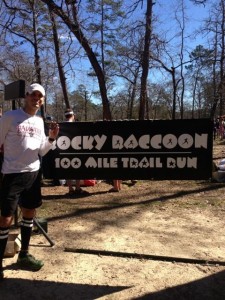 State Trooper Larry West Will Run the Boston Marathon to Support Kids with Cancer
State Trooper Larry West Will Run the Boston Marathon to Support Kids with Cancer
By Alix Shutello
After mistakenly running off-course in his second marathon, state trooper Larry West ran just short of 28 miles. The race director of the Gusher marathon in Beaumont, Texas proclaimed, “You just ran your first ultra.”
And from there, an ultra-runner was born – all due to a traffic error in a local marathon. West then started researching endurance races and training for longer distances. Two years later, in 2011, he ran the Rocky Raccoon 50 in Huntsville, Texas…but he had his heart set on going even farther.
“While researching ultra marathons, I became captivated by the Badwater ultra marathon in Death Valley. I was invited to pace for veteran Badwater runner Cheryl Zwarkowski, provided I finished my first 50-miler.”
The problem was, the Rocky Raccoon 50-miler was so hard, West proclaimed he would never run again.
“Mile 46 was and is still to date the worst moment physically of my entire life,” West said. “However, once I finished and recovered, I signed up for three 100-milers in an attempt to qualify for Badwater within one year (ultimately, it took me one and a half years). Meanwhile, I paced Cheryl at Badwater the summer of 2011, and I ran my first 100-miler at Arkansas Traveler 100 in October of 2011.”
 West went on to run Badwater in 2013, but not before he saw the tragedy at the Boston Marathon in April and was compelled to do something to help. Fortunately, he came upon a small article in “Runners World” that included information on an organization called Cops for Kids with Cancer. Being in law enforcement and having run three 100-milers, West felt the 2014 Boston Marathon might be an opportunity to use his ability to run for others, and reached out to the group.
West went on to run Badwater in 2013, but not before he saw the tragedy at the Boston Marathon in April and was compelled to do something to help. Fortunately, he came upon a small article in “Runners World” that included information on an organization called Cops for Kids with Cancer. Being in law enforcement and having run three 100-milers, West felt the 2014 Boston Marathon might be an opportunity to use his ability to run for others, and reached out to the group.
“The charity typically gives each family $5,000 for those involved directly in the care of children with cancer. Their website is http://copsforkidswithcancer.org,” West said.
There is a website set up for the charity: http://www.crowdrise.com/CFKWC2014BostonMarathon/fundraiser/Mile46
Videos with a local story on Larry are at: https://www.youtube.com/watch?v=1q-6pTyQgUw
]]>By Earl Furfine
Hi, Endurance Racing fans. I trust everyone is getting ready for a great season. I have just completed this year’s first century ride, the MS Breakaway from Miami to Key Largo, in preparation for Ironman Texas. A very well-run ride: 100 miles completed Day 1 and 50 Day 2, followed by a 90-minute run. Not a bad weekend of training! Speaking of training and racing, we here at ERM thought it might be nice to share my top 10 training and racing tips. Most of these you have already heard or even followed, but it is always helpful to get a refresher!
1. Keep your pace early, and push near the end on long training rides. I tend to fall into pace groups that are a little fast for me. I’ve found that if I keep my HR Zone where my coach has advised for the first 70 miles, then try to hammer with a faster group for the last 30, I get a much greater benefit from the workout.
2. Manage your heart rate on the run. I am amazed at how many runners (and triathletes) can’t keep their heart rate down on climbs. By simply keeping the same cadence and shortening up your step, you will keep your heart rate down – and you’ll be amazed at how successfully you can climb even the most painful hills.
3. Keep up with your nutrition. This sounds like a simple plan but is often poorly executed. I tend to get behind on my hydration, particularly during Ironman; so I now force myself to drink every 15 minutes, as much as I can take in, up to one bottle an hour. I use sports drinks with 300 (plus or minus) calories and supplement with gel blocks. It takes a while to experiment with what you can tolerate, but have a plan on race day and don’t try anything new.
4. Flat Coke is the bomb! I was surprised when my coach mentioned that they hand this out at Ironman® rest stops. It settles your stomach (I get GU Belly on some occasions) and gives you a quick lift. Given that it is at every mile stop, the quick lift normally lasts until just about the next stop.
5. Lots of lube before, during and after the bike (enough said, and no I am not talking about your bike chain).
6. Bring fans!! I have never raced Ironman with fewer than 10 supporters. It is absolutely the way to go, especially on the run when you begin to tire. Knowing you will see a smiling, supportive face is better than any energy bar.
7. Advil. (This may not be for everyone). I normally take a few between the bike and run. Of course, consult a doctor if you are unsure.
8. My own personal rule: No Alcohol. I stop all alcohol intake 3 months out from an Ironman-distance race. I know it helps my training and recovery, but more importantly, it begins the “mind over body” training that I need during race day.
9. Carry something inspirational. I have a small gift from my girlfriend that I wear around my neck during the race. It reminds me of the sacrifices she has made for me to be able to race and provides much-needed motivation during the tough parts (mile 80 on the bike is usually mine!).
10. Have a mantra! Anyone who has seen my column knows mine: “Faith, Pace, Focus, Strength”. Faith in my training; keep my desired pace during the race; focus on the event I am currently on; and when all else fails, remind myself (our selves) we are Ironmen and women, the most mentally strong athletes around.
Everyone have a great race season. I am still, not yet on the podium…
“Faith, Pace, Focus, Strength”
]]>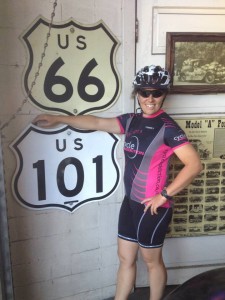 Having last been in the U.S. to compete in the Lake Anna Triple Triathlon, Christine decided a 9-year lag was enough…and back to the U.S. she came, to do the Quintuple Triathlon – and prove to herself that she could do it.
Having last been in the U.S. to compete in the Lake Anna Triple Triathlon, Christine decided a 9-year lag was enough…and back to the U.S. she came, to do the Quintuple Triathlon – and prove to herself that she could do it.
By Alix Shutello
Christine Couldrey is addicted to distance. In October 2013, “Kiwi” (as she’s known to her friends) committed to competing in the Quintuple Anvil Triathlon – the equivalent of five Ironman distance races.
The Quintuple Anvil Triathlon, which took place from October 8-13, 2013, at the bucolic Lake Anna State Park, Virginia, USA, draws endurance triathletes from all over the world. Last fall, Couldrey traveled from Australia to compete in the longest race of her career.
“I went so far as to committing to sharing a cabin in Lake Anna State Park to use as a base during the race. The conscious part of my brain was not convinced, but rationalized that logistically it would be easy, I knew the course, I could borrow all the little useful things that one needs from friends in the DC area,” she said.
Couldrey, who lives in New Zealand, has a lot of friends in the endurance world in the United States; including her friend, Aaron, who lives in DC and has shared many any ultra experiences with her. She believed he could be convinced to come and crew for her. She also has a longtime history and friendship with race director Steve Kirby – and when she heard there was a quintuple, she called to confirm that he was offering a race that long…and then got to training.
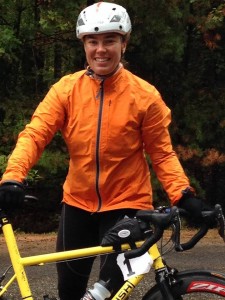 “In an ideal world, if one were going to do a quintuple Ironman, one would start training for it a year in advance – not spend weekends in the summer beekeeping, be involved in buying and selling properties, have minor surgery, be training for a major race during the dark, wet, windy months of winter in the Waikato. Sad to say, I didn’t manage to avoid any of those situations,” she mused.
“In an ideal world, if one were going to do a quintuple Ironman, one would start training for it a year in advance – not spend weekends in the summer beekeeping, be involved in buying and selling properties, have minor surgery, be training for a major race during the dark, wet, windy months of winter in the Waikato. Sad to say, I didn’t manage to avoid any of those situations,” she mused.
But Couldrey is no stranger to competing in multiday endurance races, having been involved in the endurance scene for close to 20 years. To prepare for the quintuple, she trained through the winter in sun, rain, wind and hail, often on her bike with her training buddy Annette. She also (for the first time) hired a running coach, to try to make her running more efficient.
“The coaching made a world of difference. I did my best to be a good student, work hard on my form, and it paid off,” she said. “While so many of my runs were in terrible weather, I was now able to run with less trauma to my knees and legs – and while I was very slow, I comforted myself with the knowledge that I had so much more running experience behind me than I did when I attempted the double and triple Ironman races at Lake Anna in prior years.”
She remembers how terrible the suffering was when she ran two and then three marathons during the double and triple triathlons, and wondered if she would be able to suffer through five. A mantra that her running coach, Mark Sutherland, had taught her was, “I will remain calm and positive at all times.” Couldrey had found this very useful during the Northburn 100-miler she ran a couple of years before. “Each time I struggled on a long run, I would remind myself of this, and carry on,” she said.
Kiwi started training a mere three months before the Anvil Quintuple, while camping on Whitehaven beach in Australia, which, she argues, is “one of the top 10 most beautiful beaches in the world.” She trained by swimming the 7-kilometer length of the beach, with the company of fish, stingrays and even the occasional little reef shark.
“I figured the swim was only 19 kilometers, and I knew I could do 12km from the triple, and it was going to be, by far, the shortest leg…so it deserved the smallest amount of training – right?” she said. But as race time approached, Couldrey wondered whether she had done enough. “How do you know how much is enough for a race of this length? I wouldn’t be able to answer that question until the race was over.”
Couldrey had spent many of the training hours calculating speed and formulating plans A, B and C for how the race would unfold. Aaron, her friend in DC, had also taken a very mathematical approach for her – basing his estimate on time needed for each discipline on times in previous races, working out what sort of scaling factor would be needed and then calculating the estimated total time required, presenting it to her in graphical form. It looked as though the 120 hours allowed by Steve Kirby would be enough, but there would likely not be much spare time (most quintuple races allow 144 hours).
“My main goal was to finish in under 120 hours; anything better than that would be a bonus,” she said.
That meant that after she started the quintuple at 7am Tuesday morning, October 8, 2013, she would finish by 7am Sunday morning, October 13, in her “best-case scenario” – or even by midnight or 1am on Sunday morning, so that she and her team could all go to sleep for the night and be done with it.
With the time for serious training over, Couldrey flew to the USA two weeks before the race, to give herself time to get organized before the competition began.
In a race like this, sometimes slow and steady wins the race, because the thought that you have 4.5 days left to compete – let alone 4.5 hours in one of your swim, bike, or running phases – can be hell on the mind. Couldrey went on to complete the swim phase in 6 hours and 40 minutes. Then it was on to the bike phase, 900 kilometers done 112.5 times over an 8km loop. Couldrey reminisced how difficult that up-and-back loop was 9 years ago when she competed in the triple, and how much easier it is training at home around Lake Taupo.
“As the hours go on and on, the real competition starts for all the athletes as you switch back and forth between competing against others and competing against yourself. There is a constant need to keep mentally focused as the days and nights blend together and you begin to rely more and more on your crew to feed you, get you to sleep, feed you, get you back on to the bike or back on your feet,” Couldrey related. “In the plan, I was going to sleep for 3 hours, between about 1:30 and 4:40am. I don’t think I quite made it to 1:30 before deciding I was too tired to carry on (again, worried about crashing my bike), but it was pretty close. A shower for the first time in 44 hours, some pasta and into bed. Three hours of glorious sleep. For the first time in the race, I slept solidly and deeply. Three hours later, the sleepiness of the previous day was forgotten, and after some porridge I was out there again to finish up the bike loop.”
After the bike phase was finished, it was Friday; and now Couldrey had two more days of competition to get her over the finish line. Now came 65 running laps – or 5 marathons – she had to endure. The first two marathons were relatively easy, but into marathon three, things seemed to slow down.
“With the coming of darkness, came some tiredness…and with tiredness comes a lack of patience, and with that, the pain becomes suffering,” Kiwi said. “While it wasn’t too bad until the last lap of the third marathon, lap 39/65 was perhaps the worst lap of the entire run. I struggled my way up to the turnaround, and there I met one of the volunteers, whose name I forget, but who was always so encouraging; and every time he saw me, he made a comment about how I was always smiling – often leaning out the window of his vehicle and saying “There’s that smile!” as he drove past. I said to him, ‘It’s taken 3 ½ days of racing, but my smile has gone!’ – and he wouldn’t accept that.”
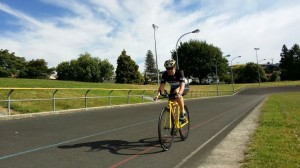 It gets maddening to see competitors finish their respective races, and Kiwi became frustrated at seeing her friends finishing their races – and as she entered marathon 5 she had to keep in mind than many were finishing their triple and quadruple triathlons; she was finishing her fifth.
It gets maddening to see competitors finish their respective races, and Kiwi became frustrated at seeing her friends finishing their races – and as she entered marathon 5 she had to keep in mind than many were finishing their triple and quadruple triathlons; she was finishing her fifth.
But as she neared the end of her race, “something amazing happened.” With 4 laps (10km) to go, Kiwi had the beacon of hope in her hand, as it had gotten dark and her brain completely overrode anything her body was saying. After walking for miles and miles, she wanted to want to run, as opposed to making herself run.
“I didn’t want to walk anymore, I was just going to run….so run I did. I was nearly there. But I still couldn’t let myself think about finishing…I needed to preserve the little bit of patience I had…but all of a sudden, it wasn’t suffering anymore; I had a job to do and I was doing it,” She said.
Even on the last lap, Kiwi couldn’t let herself think of the finish until she had only half a kilometer to go. She said good-bye to the athletes still on the course and finally picked up the flag, and walked the last 100 meters with her friends, listening to her national anthem.
“I was so very incredibly proud of what I had done,” she said.
Right before the race, Couldrey posted a question on Facebook: “How do you race a quintuple Ironman?” Now she knew the answer: One step at a time, with unwavering patience, making sure your brain is happy, separating physical pain from emotions, and trusting your friends.
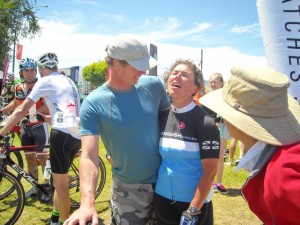 “The quintuple Ironman is by far the hardest thing I have done in my life; but I am so happy that I did it, and I finished hours ahead of my ‘best-case scenario’…what more could I want?”
“The quintuple Ironman is by far the hardest thing I have done in my life; but I am so happy that I did it, and I finished hours ahead of my ‘best-case scenario’…what more could I want?”
To learn more about the Double and Triple Anvil Irons, visit: USAUltraTri.com.
]]>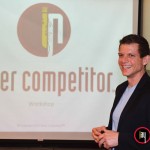
Fortune 500 Leadership Coach, Sports Performance Coach
Jay Markiewicz: Inner Competitor® Training, Part 2
I recently sat through a lecture on mental toughness. One of the “tools” the presenter offered was to relax when racing. “Just relax.” I looked over at my fellow attendees and saw the frustration on their faces. The same question was running through everyone’s head: “What do I do to attain a state in which I am relaxed?” Seriously, how often do we hear that in order to be mentally tough, one should just “relax”, “focus,” “grit,” “have confidence,” and my all-time favorite be-tough tool – “Overcome your fears!” There it is! Just be fearless! Tell that to a wide-eyed, first-time Ironman triathlete standing on the beach of a mass swim start. “Yo, dude, be fearless!”
I want to share with you a nugget that will change your approach to mental ability from here forward.
Let me frame this nugget: The professional field of “Leadership” is focused on the qualities and characteristics that describe effective leaders; the field of “Leadership Development” is focused on the set of actions, frameworks, and tools to improve as leaders.
Your nugget is that this same distinction applies to athletics – particularly with regard to mental ability. Recognize the distinction between “mental ability” and “mental ability development”. To me, mental ability is focused on the mental qualities and characteristics that describe high-performing athletes, and mental ability development is the set of actions, frameworks, and tools to improve as athletes.
Fearless is a quality. You want the actions and tools to get you to “fearless”.
So with this idea, let’s continue with the actions and tools in our series’ Inner Competitor® training plan to perform better and enjoy the sport more. If you have yet to read Part 1 of this series, you can find it Coaches Corner or in the Jan/Feb 2014 Issue of Endurance Racing Magazine.
To recap what you learned in my first article:
- Your brain is designed to minimize danger and maximize reward. As an athlete, you are often faced with situations your body will determine as requiring “threat response” – thereby minimizing danger.
- When experiencing a threat response, your athletic performance and enjoyment is at high risk (and by the way, when you are at work and in a threat response, your ability to perform your job at a high level is at risk, too).
- The threat response process includes your inner voice and emotions.
- Your competence at managing through the threat response leads to elevated performance and enjoyment.
- The first step to training your brain and gaining competence in managing the threat response is the intentional action of noticing.
Now, ask yourself the following questions:
- What are your three or four main tendencies when performing?
- What data do you focus on when it gets hard? When it’s going great?
- What are the top 10 situations that kick off your threat response?
- What top five things do you find yourself noticing when performing (weather, Garmin data, course, feel, body, etc.)?
Part 2 of your training plan is an expansion of Noticing, summed up with the motto: “Pay attention to what you are paying attention to!” In other words, notice what you are noticing.
I have to admit this is one of my favorite concepts, because it truly is a game-changer. The more competent you become at “paying attention to what you are paying attention to,” the better you will perform as an athlete. Period. Not only will you perform better as an athlete, you may find yourself performing better as a parent, coworker, and boss, too!
Let’s kick-start this level of Noticing. Write down everything you remember from your last workout (this is most likely what you noticed). Ask yourself: What do I remember about the weather, course, equipment, data, performance metrics, body, feeling, thinking, inner voice? This is what you are paying attention to.
The two things you are doing right now to “pay attention to what you are paying attention to” are:
- Taking a moment to look at everything you just wrote down, and recognizing any themes; and
- Listing the top five things you find yourself noticing when performing.
- This is the process of developing awareness.
With practice, you will become aware in real time, as it happens – then the real magic begins! Boom! You will look at your Garmin data and say, “Oh hey, I am paying attention to my Garmin data, hmm” – bringing smack-dab to your consciousness that you are choosing to notice Garmin data.
This concept can feel a little heady at first; stick with it! Physical training stresses your muscles; brain training stresses your brain! When I learned about this concept at Georgetown’s Leadership Coaching program, I was so scrambled that I didn’t know what the heck was going on; I don’t think I had a sensible thought the rest of the day. However, the good news is that with practice, this process becomes second nature.
To see more on why this is important, and to get a sneak preview of Part 3, check out http://innercompetitor.com/video-inner-competitor-at-endorphin-fitness-2/#.UxTrmdxJ-Qd
In the meantime, give yourself grace and have a lighthearted approach to your mental ability development. At the end of the day, enjoyment and performance go hand in hand.
Rock!
Jay
Jay Markiewicz is an endurance athlete and Fortune 500 Leadership Coach, Sports Performance Coach, and founder of Inner Competitor® – an organization that works with clients who want to perform better and enjoy their life more. You can contact Jay at [email protected].
]]>